The Intel Core Ultra 7 155H Review: Meteor Lake Marks A Fresh Start To Mobile CPUs
by Gavin Bonshor on April 11, 2024 8:30 AM ESTASUS Zenbook 14 OLED UX3405MA: Graphics Performance (Arc vs Radeon)
Moving onto gaming performance, Intel has gone all out for Meteor Lake when it comes to integrated graphics by incorporating their discrete-based Arc graphics into a more power-efficient mobile package. Designed with Arc performance for mobile, Intel includes their latest Arc Xe LPG graphics cores into Meteor Lake, which includes eight Xe cores designed to provide good performance levels.
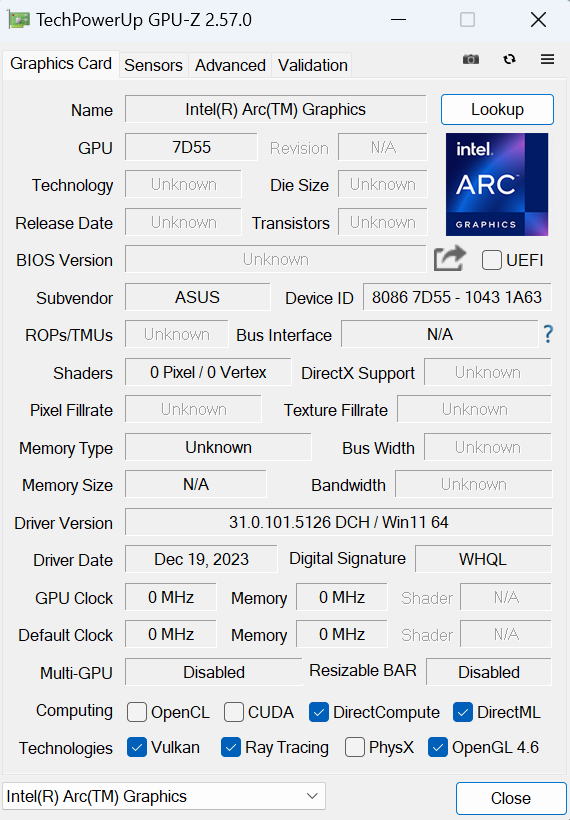
Screenshot of the Intel Core Ultra 7 155H with Arc Xe Graphics in GPU-Z
Regarding competition, AMD's mobile Radeon 780M and 760M graphics use their RNDA3 graphics architecture. The AMD Ryzen 9 7940HS and Ryzen 7 8700G both include the Radeon 780M, which includes twelve RDNA3 CUs, while the Ryzen 5 8600G uses the Radeon 760M, which is similar in design to the 780M but has just eight RDNA3 CUs. In relation to comparing both architectures, the Radeon 780M is Intel Meteor Lake's primary competition in the integrated mobile graphics arena.
Notably, here, the Ryzen 9 7940HS laptop is only using DDR5-5600 via SO-DIMMs, rather than soldered-down LPDDR5X. As a result it comes into this contest with a memory bandwidth deficit. Though by how much is uncertain, as current hardware info tools are not correctly reading the LPDDR5X memory speeds on Meteor Lake devices. Our best guess for now is that this would be paired with LPDDR5X-8533.
On the flip side, as we established with our look at power consumption, the Ryzen 9 7940HS laptop is able to sustain a much higher TDP overall – so that memory bandwidth deficit is counterbalanced by a sizable TDP advantage.
For this review, we will focus on gaming performance at 1080p, which is the most commonly used gaming resolution according to the latest Steam survey, and given these are mobile chips, we've opted for middle-of-the-road settings using the Medium preset.
Gaming Performance @ 1080p Medium Settings
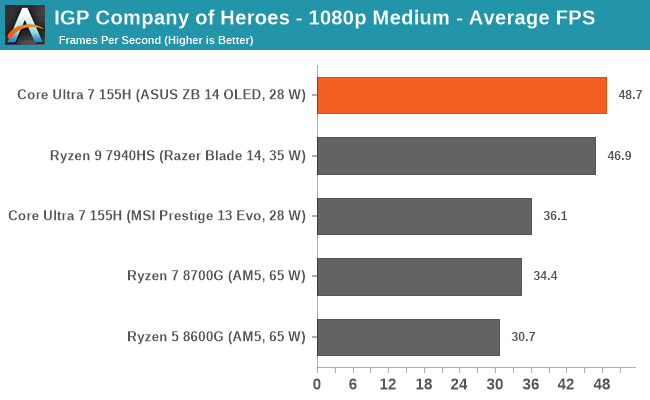
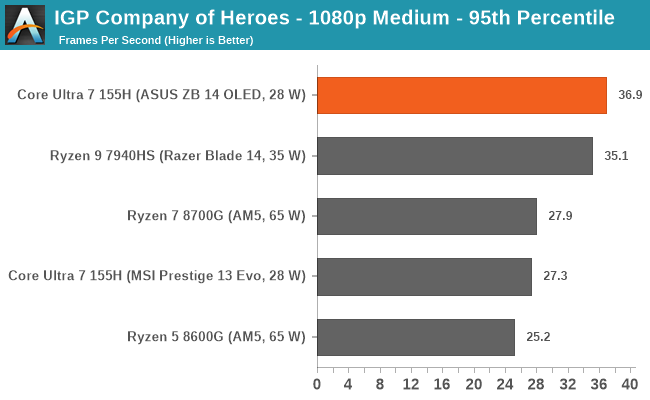

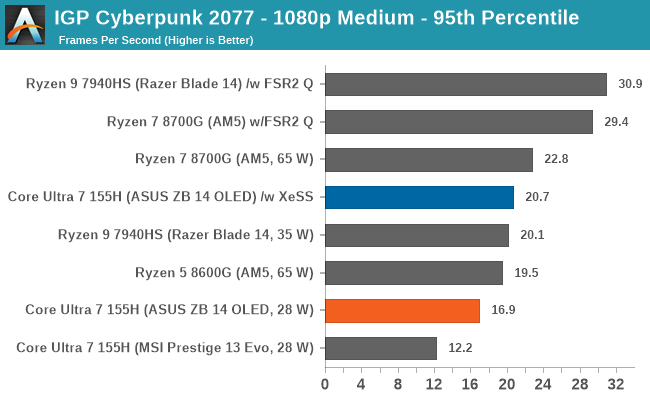
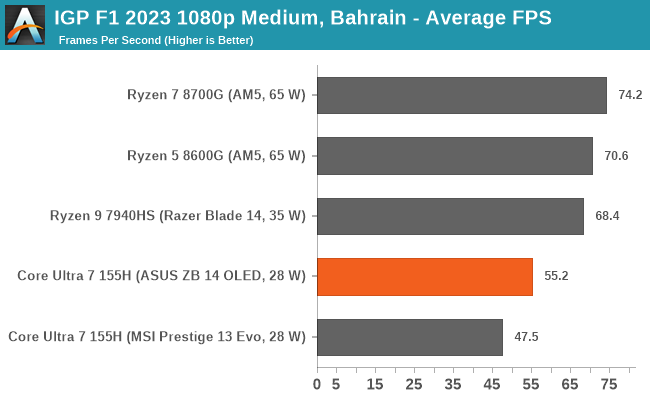
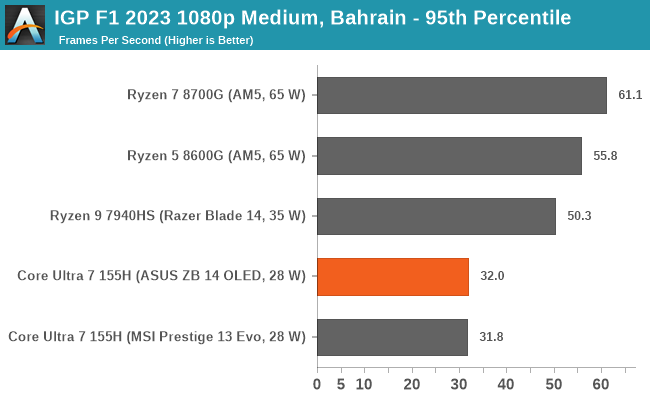
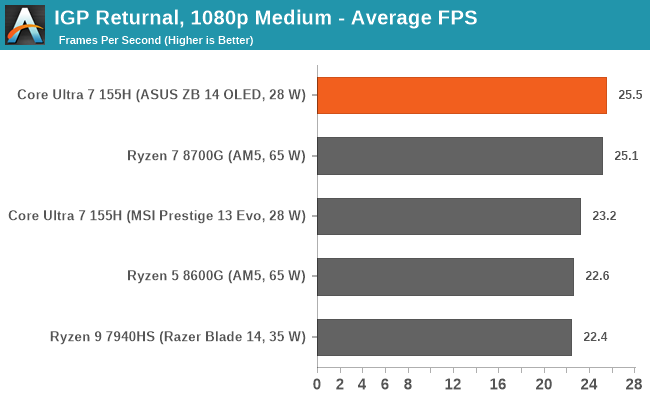

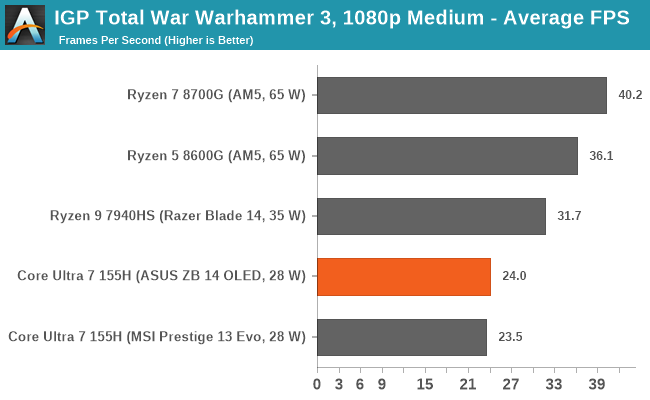
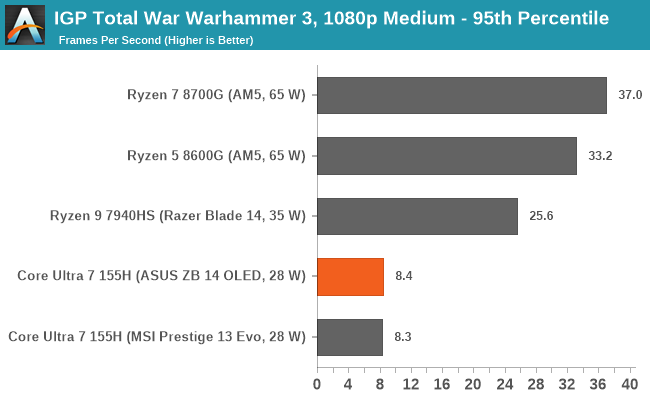
Looking at gaming performance with the 1080p resolution and medium preset across all the games, we can see that the ASUS Zenbook 14 OLED UX3405MA is very competitive with the Razer Blade 14 with the Radeon 780M chip in Company of Heroes 3. Looking at the other titles, such as Cyberpunk 2077 and F1 2023, we can see that performance lags slightly behind the integrated Arc Xe graphics when compared directly to AMD's RDNA3 architecture. The difference isn't night and day, but certainly enough to consider the Radeon 780M, the superior integrated graphics chip combined with the Zen 4 cores, even when set at 35 W.
In Returnal, Intel's Core Ultra 7 155H within the ASUS Zenbook 14 OLED performs very well, although in Total War Warhammer 3, the Meteor Lake chip displays fairly reasonable average frame rates but bottoms out massively in the 5% low framerates; this is on both the ASUS and MSI ultrabooks.
We can also see a pattern where the ASUS Zenbook 14 OLED is considerably ahead in some games than the MSI Prestige 13 Evo A1MG, despite featuring the same Core Ultra 7 155H processor. This is because the MSI notebook is actually smaller and ultimately runs with less power overall than the ASUS model. This is prevalent in our peak power testing.
Overall, there are certain benefits to Intel's Arc Xe LPG integrated graphics in Meteor Lake, and for the best part, it's competitive with the AMD Radeon 780M and 760M. We also feel that if the Intel pair of ultrabooks had better cooling, performance could be even greater, as we saw in our power analysis. That being said, Intel's Arc Xe LPG graphics work, and given that it's Intel's first go at a tiled architecture in their mobile portfolio, it provides a solid stepping stone to the next generation.










69 Comments
View All Comments
Dante Verizon - Thursday, April 11, 2024 - link
Too strange... in the spec2017 test that represents Blender MeteorLake wins but in the real Blender test it loses? GreatDante Verizon - Thursday, April 11, 2024 - link
The iGPU performance of desktop APUs is also abnormally low.Gavin Bonshor - Friday, April 12, 2024 - link
Could you please elaborate? Did another publication's results land higher? Did they run JEDEC memory settings?ballsystemlord - Thursday, April 11, 2024 - link
That near 50% increase in DRAM access latency coupled with the higher thermal limitations is probably what's holding the 115H back.Ryan Smith - Thursday, April 11, 2024 - link
Keep in mind that they're different workloads with different versions of Blender. The version in SPEC2017 is from 7 years ago, which was the Blender 2.7 era.mode_13h - Monday, April 15, 2024 - link
spec2017 is using an old version of Blender that's frozen in time. That's needed to make all spec2017 results comparable with each other.In the individual Rendering benchmarks, Gavin used a reasonably current version of Blender (3.6 is a LTS release from June 27, 2023), probably also built with a different compiler.
Hulk - Thursday, April 11, 2024 - link
"AMD Arc" in GPU specs?Gavin Bonshor - Friday, April 12, 2024 - link
Yeah, that was a really weird one. It has since been corrected.Fozzie - Thursday, April 11, 2024 - link
Why is the text seemingly out of line with the actual results? Repeatedly it is describing wins for the U7 155H that don't seem to be backed up in the actual benchmarks. For example:"As we can see from our rendering results, the Intel Core Ultra 7 155H is very competitive in single-threaded performance and is ahead of AMD's Zen 4 mobile Phoenix-based Ryzen 9 7940HS."
Actually, the graphs don't show a single instance of the Ultra 7155H besting the Ryzen 9 7940HS in ALL of the preceding graphs.
"Looking at performance in our web and office-based testing, in the UL Procyon Office-based tests using Microsoft Office, the Core Ultra 7 155H is actually outperforming the AMD Ryzen 9 7940HS, which is a good win in itself."
How is 6,792 greater than 7,482? How is 6,978 higher than 7,162?
Did the benchmarks get updated after the text was written? Did someone write the summary text and not pay attention to "Higher is better" vs "Lower is better"?
phoenix_rizzen - Thursday, April 11, 2024 - link
The text describing the Spec tests are also incorrect."Even though the Core Ultra 7 155H is technically an SoC, it remains competitive in the SPECint2017 section of our single-thread testing against the Ryzen 9 7940HS. The AMD chip performs better in two of the tests (525.x264_r and 548.exchange2_r); on the whole, Intel is competitive."
Except the graph shows the AMD system beating the Intel system in 7 tests and only losing by a small margin in 3 of them. The AMD system even beats the Intel desktop system in 4 tests and ties it in 1.
"In the second section of our single-threaded testing, we again see a very competitive showing in SPECfp2017 between the Intel Core Ultra 7 155H and the AMD Ryzen 9 7940HS. The only test we see a major gain for the Ryzen 9 7940HS is in the 503.bwaves_r test, which is a computational fluid dynamics (CFD) simulation."
Except the AMD system wins in 4 tests, essentially ties in 5 tests, and only loses in 2. It even beat the desktop system in 3 tests.
The text is nowhere near consistent with the graphs.